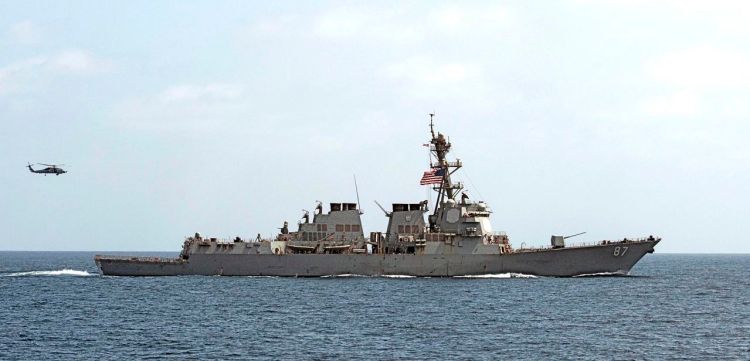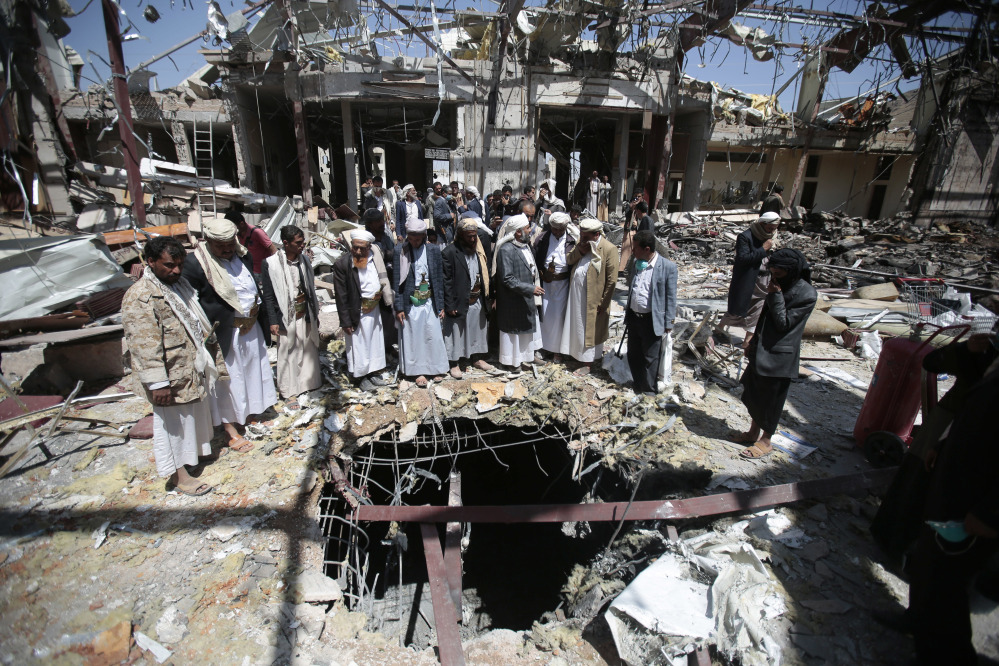SANAA, Yemen – The United States carried out strikes against Yemen’s Shiite Houthi rebels for the first time in that country’s civil war, destroying three coastal radar sites with Tomahawk cruise missiles in retaliation for missile fire earlier this week toward U.S. Navy ships.
The strikes early Thursday point to the potential for the U.S. to be dragged into a greater role in Yemen’s war. For more than a year, Washington has been backing the Saudi-led coalition waging a fierce air campaign against the Houthis and their allies. But American forces had not previously targeted the rebels directly.
But it appears the Houthis lashed out at the United States with the missile fire against its ships in retaliation after warplanes from the Saudi-led coalition struck a funeral in the Yemeni capital Sanaa last weekend being attended by senior rebel figures. The devastating strikes killed nearly 140 people, most of them civilians.
Human Rights Watch said Thursday that the funeral bombing constitutes an apparent war crime. It also called on the United States and Britain to immediately suspend all arms sales to Saudi Arabia. The two countries have sold the kingdom billions of dollars in weapons for use in the Yemen campaign, and the U.S. military has provided logistical and intelligence support as well.
In Thursday’s U.S. strikes, the destroyer USS Nitze launched the cruise missiles, according to an American military official. At around 7 a.m., the missiles hit radar sites in three locations along the Red Sea coast, Ras Eissa, Khoukha and Makha, according to Col. Walid Zeyad, a Yemeni naval official in the nearby Red Sea port of Hodeida.
No information on casualties from the U.S. missiles was provided by American officials. The American military official said the sites were in remote areas, where there was little risk of civilian casualties or collateral damage. The official spoke on condition of anonymity because he was not authorized to talk to the press.
President Barack Obama authorized the strikes at the recommendation of Defense Secretary Ash Carter and the chairman of the Joint Chiefs of Staff, Gen. Joseph Dunford, Pentagon press secretary Peter Cook said in a statement.
“These limited self-defense strikes were conducted to protect our personnel, our ships and our freedom of navigation in this important maritime passageway,” Cook said.
He said the U.S. will work to ensure navigation in the Red Sea and Bab al-Mandeb, a vital strait off Yemen through which shipping between Asia and Europe through the Suez Canal must pass.
In a sign of the regional scope of the Yemen conflict, Iran announced Thursday it was deploying two warships in Bab el-Mandeb and the neighboring Gulf of Aden. The semi-official Tasnim news agency said the Alvand and the Bushehr were being deployed as part of a regular anti-piracy patrol off Yemen and East Africa.
Still the timing of the announcement, just hours after the American strikes, suggested it was aimed at sending a signal to the U.S. Iran says it backs the Yemeni rebels but denies arming them. That’s contradicted by the U.S. Navy, which says it has intercepted several shipping boats since the war began carrying Iranian weaponry suspected to be on the way to Yemen.
The U.S. strikes were prompted by two incidents of missile fire from Houthi-held territory toward the USS Mason and USS Ponce, one on Sunday and a second early Wednesday. The missiles fell harmlessly in the ocean in both cases. The missiles fired Sunday were variants of the so-called Silkworm missile, a type of coastal defense cruise missile that Iran has been known to use.
Sharaf Loqman, a spokesman for the part of the Yemeni army fighting alongside the Houthis, denied firing on the ships, saying the military never targets ships outside territorial waters. He called the accusations an “American farce to find a reason to interfere in Yemen directly after failure of the Saudis.”
Yemen’s state news agency Saba, which is under Houthis’ control, also carried a denial, saying the accusations aim to create a pretext “to escalate assaults and cover up the continuous crimes committed by the aggression against the Yemeni people.”
Still, observers believed the missile shots were a move by the Houthis to expand the conflict – or at least signal to the U.S. the danger of expansion – after the bloody coalition strike on the Sanaa funeral.
Saturday’s strike on the funeral in Sanaa was one of the deadliest by the Saudi-led coalition since its air campaign began in early 2015. Afterward, the U.S. said it would review its support for the coalition.
The air campaign and ongoing ground fighting have left over 4,000 civilians dead and more than 7,000 wounded. Rights groups have documented coalition bombings that struck weddings, markets, schools, and hospitals.
After the funeral hall bombing, coalition officials announced an internal investigation of the funeral strike. In its statement Thursday, Human Rights Watch demanded an independent international investigation. The group’s Middle East director, Sarah Leah Whitson, called the strike an “atrocity” that joins a long list of abuses by the coalition.
The group said a disproportionate number of the victims were civilians and that remnants of munitions found at the site of the attack showed that they were American made.
Baldor reported from Washington. Associated Press writers Jon Gambrell in Dubai, United Arab Emirates, and Nasser Karimi in Tehran, Iran, contributed to this report.
Send questions/comments to the editors.




Success. Please wait for the page to reload. If the page does not reload within 5 seconds, please refresh the page.
Enter your email and password to access comments.
Hi, to comment on stories you must . This profile is in addition to your subscription and website login.
Already have a commenting profile? .
Invalid username/password.
Please check your email to confirm and complete your registration.
Only subscribers are eligible to post comments. Please subscribe or login first for digital access. Here’s why.
Use the form below to reset your password. When you've submitted your account email, we will send an email with a reset code.